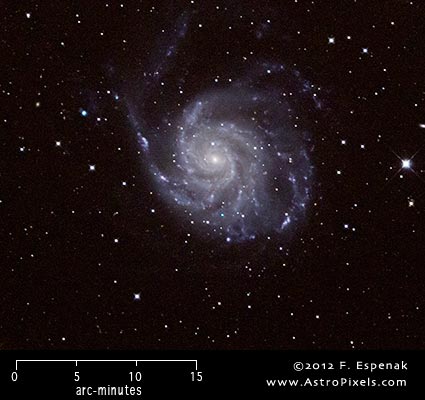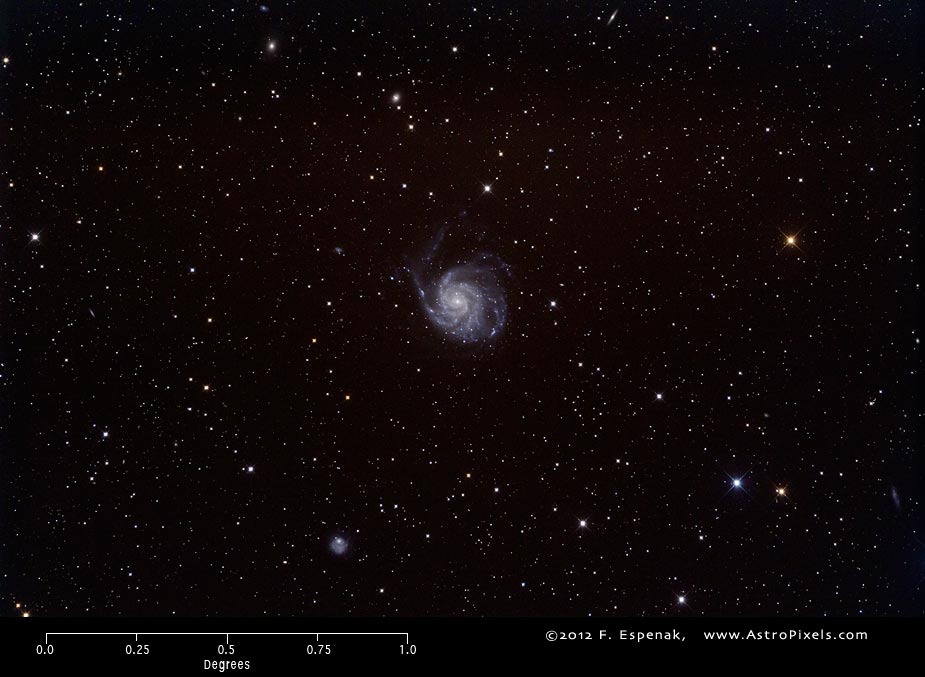
M101 - Pinwheel Galaxy
Messier 101 or M101 (also designated NGC 5457) is a spiral galaxy in the constellation Ursa Major. It has an apparent visual magnitude of 7.9 and its angular diameter is 22 arc-minutes. M101 lies at an estimated distance of 27 million light years. The Equinox 2000 coordinates are RA= 14h 03.2m, Dec= +54° 21´ which makes M101 best seen during the spring. The Messier Spring Star Chart shows the position of all Messier objects visible during that season. As one of the more famous objects in the Messier Catalog, it is commonly known as the Pinwheel Galaxy.
The image above shows the uncropped view of M101 through the Takahashi E-180 Astrograph (North is up). A 2x enlargement of this image appears to the right.
This spiral galaxy was discovered by P. Méchain in 1781. The 3rd Earl of Rosse identified it as a "spiral nebulae" in 1851. The Pinwheel Galaxy is a face-on spiral which appears somewhat asymmetric. According to Stoyan et al. (2010), the distance of M101 is 21.8 million light years and its diameter is 184,000 light years. This makes it about twice the size of the Milky Way Galaxy. Its mass is on the order of 100 billion solar masses.
For more information, see the Messier Catalog as well as specific entries for M101 in Wikipedia and SEDS.
Messier's Description of M101
March 27, 1781
`Nebula without star, very obscure and pretty large, of 6 or 7 minutes
[of arc] in diameter, between the left hand of Bootes and the tail of
the great Bear [Ursa Major]. It is difficult to distinguish when one lights
the [graticule] wires.'
(diam. 7')
Technical Details
- Object: M101
- Other Names: NGC 5457, Pinwheel Galaxy
- Object Type: spiral galaxy
- Object Data: Apparent Magnitude = 7.9, Angular Size = 22 arc-minutes
- Object Position (Equinox 2000): RA= 14h 03.2m, Dec= +54° 21´, Constellation = Ursa Major
- Date/Time: 2012 Jan 29 at 11:15 UTC
- Location: Bifrost Astronomical Observatory, Portal, AZ
- Mount: Astro-Physics 1200GTO
- Telescope: Takahashi Epsilon 180 Hyperbolic Astrograph
- Camera: Canon EOS 550D (Rebel T2i) (modified with a Baader UV/IR filter)
- Field of View: 1.70° x 2.56° at 1.7 arc-sec/pixel (web version: 10.0 arc-sec/pixel)
- Exposure: 4 x 300s, f/2.8, ISO 800
- File Name: M101-01w.jpg
- Processing (Adobe Camera Raw): Graduated Filter, Vignetting Correction, Noise Reduction, White Balance, Curves
- Processing (Photoshop CS5): Average Images, Curves, Noise Reduction
- Original Image Size: 3454 × 5179 pixels (17.9 MP); 11.5" x 17.3" @ 300 dpi
- Rights: Copyright 2011 by Fred Espenak. All Rights Reserved. See: Image Licensing.
